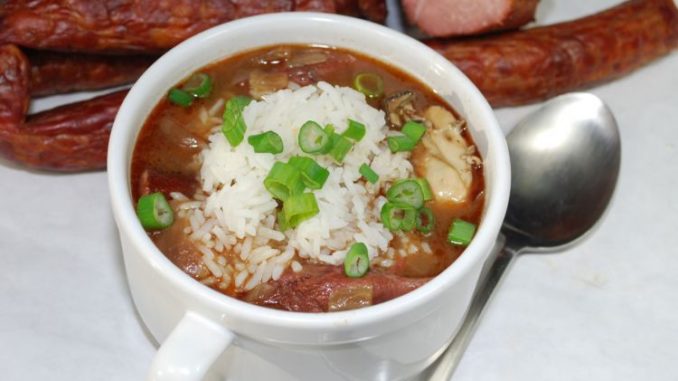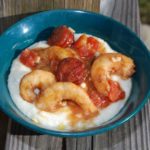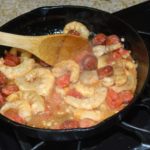
But don’t use ‘spicy wieners’
For the uninitiated, Cajun cooking is the same wherever bonafide Cajuns exist.
But as a born and bred Cajun, Tony Soileau knows better. The 47-year-old dentist lives in Lafayette now, but he was raised in Pine Prairie in Evangeline Parish.
“In Lafayette, they do a lot more with Gulf seafood, but they don’t smoke meat as heavily as we do in Evangeline Parish,” Soileau said. “Pine Prairie has three different grocery stores that sell smoked meats: Guillory’s, Guidry’s and Landreneau’s. All three are different, but all three are similar.
“Their meats have a heavy smoke aroma. Other South Louisiana sausages are just big, spicy wieners in sausage casings. I can’t use their sausage to season gumbo or shrimp.
Shrimp?
“Oh yes. Any time I cook shrimp, I want sausage next to it,” Soileau said. “But you can’t use a spicy wiener. For us, we tend to take meat to another level. I use smoked meats a lot more as cooking ingredients than to just eat.
“I even use tasso on salads. Shave thin slices and sear them until they are crisp. Then chop them finely with a knife like bacon bits. I love smoked meat on corn — any kind of corn. The saltiness of the meat with the sweetness of the corn really works. Smoked meat is great in corn bread, too.
“A cochon de lait is a normal event for us. It takes eight to 12 hours to season and marinade the meat, then two to three hours to prepare the coals and then six to eight hours to cook it in a pit in the ground — what a modern ‘Cajun microwave’ simulates.
“Barbecue is huge for us, but always revolves around Jack Miller’s or Pig Stand BBQ sauce. For us, a hamburger or a hot dog always has one of the two sauces on it. The basic essentials are a bun, Jack Miller’s and meat. Ninety percent of the hamburgers we eat are just that — nothing else.
“I like to parboil chicken gizzards until tender (about an hour) put them in a bowl and mix Jack Miller’s with them. Then throw them on a grill and cook until the sauce caramelizes. It’s like popcorn.
“Pork steaks are a very common thing to barbecue. My family and others always went to the Pig Stand (in Ville Platte) for them after Mass on Saturday or Sunday.
“The Smoked Meat Festival is a big event that we went to every year. I was always on a team that competed. We never won, but we drank a lot. We won the award for having a good time.”
Soileau honed his skills cooking at camps. Cooking a supper at a camp was a men’s event, he explained.
“Fathers teach cooking to their sons,” he said. “Women cook at home. Not learning to cook wasn’t an option. Daddy cooks; I cook.
“Common foods were any wildlife. Real regulars are duck, squirrel, deer and rabbit. Ducks were most common, usually in a gumbo or baked in the oven. In the summer, we would fry fish and frogs. Oddities include turtle, nutria, alligator, coon and possum.
“We will eat anything that fits in a pot, and if batter will stick to it, we will fry it.”
Duck and Oyster Gumbo
Duck or goose gumbos were a very popular dish when men cooked at camps while Tony Soileau was growing up. This version came about when the guy who was supposed to bring gizzards for the gumbo brought oysters instead.
“I cook it two or three times a year now,” Soileau said. “It still tastes like duck gumbo but with a hint of oysters in it.”
Tony cooks his gumbos in a 6-quart pressure cooker, but feels guilty about it.
“I really fought this,” he said. “You are supposed to cook gumbo in a cast iron pot for hours and hours. The longer you cook it, the better.
“Both my wife and I work long hours. Some Cajun meals don’t lend themselves to quick cooking. I bought a pressure cooker for making beans and rice, and began experimenting.
“I get a little knot in my stomach when I use it. I feel guilty, but I can come home and eat gumbo in one hour instead of two or three hours. It tastes just as good as one cooked in a cast iron pot, but in a third the time.
“My father still doesn’t believe it.”
INGREDIENTS:
- 5 medium duck breasts,
- preferably bone-in
- 1 tbsp. olive oil
- 1 lb. smoked sausage, cut into 1-inch pieces
- 4 oz. finely diced tasso
- 2 32-oz. containers chicken stock, divided
- 1 medium bell pepper, finely chopped
- 1 large onion, finely chopped
- 4 tbsp. minced garlic
- 11/2 pints oysters, drained and divided
- 8 oz. jarred dark roux
- Salt and pepper to taste
- 1 bunch green onions, chopped
PREPARATION:
Rinse the duck breasts and set them aside. Add olive oil to pressure cooker and turn setting to “brown.” Wait 30 seconds, and then add the sausage and tasso. Cook until lightly browned, stirring occasionally. Add 1 container chicken stock, bell pepper, onion, garlic, and duck breasts to the cooker. Add 1/2 pint of oysters and enough of the other container of stock to fill the cooker to the max line. Stir in the roux. Cover and set the cooker on “stew” which cooks for 30 minutes. Release the pressure and check the larger duck breasts with a fork. If they are tender, cook for 10 more minutes. Add the remaining oysters and allow the residual heat of the gumbo to cook the oysters until their edges curl. Salt and pepper to taste and sprinkle in the green onions before serving over rice. Serves 6 to 8.
Shrimp and Sausage with Grits
Tony Soileau said he grew up with his mother making eggs and grits. When shrimp and grits became a popular national dish, he began experimenting.
“In Evangeline Parish, we cook everything with sausage, so I put sausage in mine from Day 1,” Soileau said. “It’s so traditional for us.”
When asked about sausage being traditional, he laughed loudly.
“Because without the sausage, the saints will pray for you to go to Hell,” Soileau said.
INGREDIENTS:
- 4 oz. finely diced tasso
- 3 tbsp. olive oil, divided
- 11/2 lb. peeled medium shrimp tails
- 2 links smoked sausage, cut into 1-inch pieces
- 6 tbsp. butter
- 3 tbsp. minced garlic
- 1 141/2-oz. can diced tomatoes
- 2 cups milk
- 2/3 cup quick (5-minute) grits
- 1/2 cup grated parmesan cheese
- 1 4-oz. can whole kernel corn, drained
- Salt and pepper to taste
PREPARATION:
In a small pan over medium heat, fry the tasso in 11/2 tbsp. olive oil until it is browned. Remove and set aside. Add the remaining olive oil to a larger pan. Heat over medium heat until the oil is hot but not smoking. Add the sausage and fry, stirring often, until it is brown. Reduce heat to low and add 3 tbsp. butter. After it is melted, add the shrimp, garlic and tomatoes. Stir-fry until shrimp are pink, 1 to 2 minutes. Remove the pan from the burner and set it aside. Add 3 tbsp. butter and the milk to a sauce pan over low heat. When the butter is melted and the milk is beginning to steam, stir in the grits. Continue to stir vigorously to incorporate air into the grits and make them fluffy. Care must be shown here: The grits will thicken very suddenly and become too thick if they are not whisked enough. When grits begin to thicken, whisk in the tasso and Parmesan cheese. After blended, stir in the corn and then turn off the heat. Salt and pepper to taste. Place servings of grits in individual bowls and spoon the shrimp over the grits. Serves 6.






